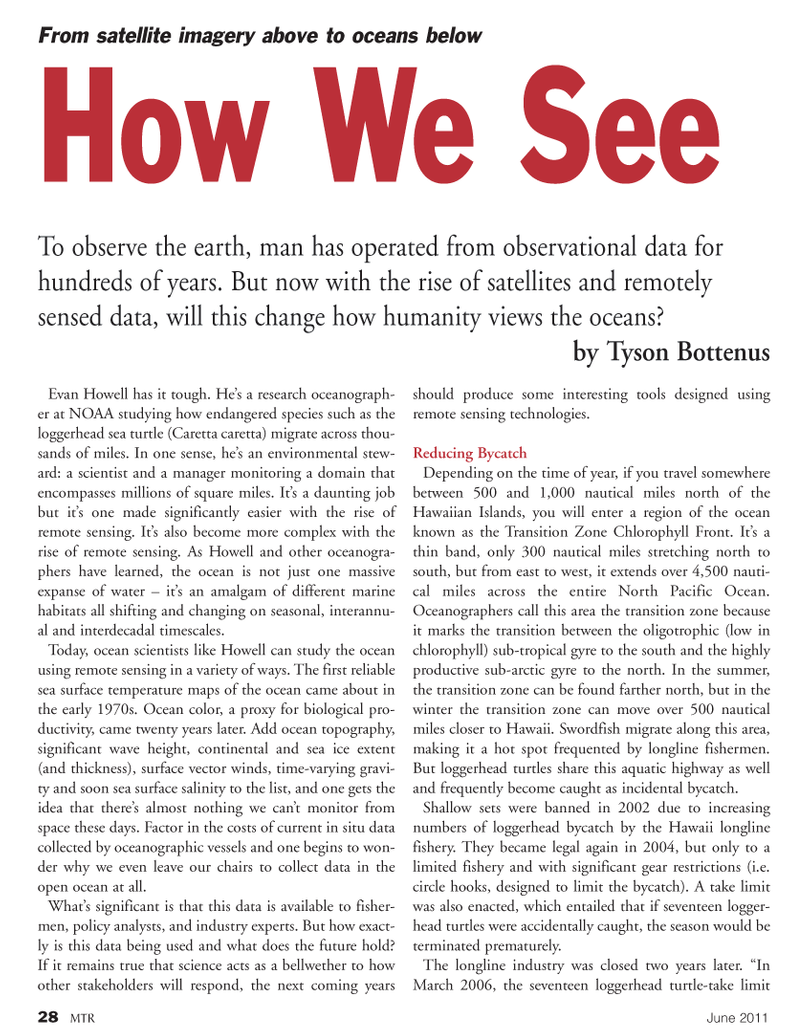
Page 28: of Marine Technology Magazine (June 2011)
Hydrographic Survey
Read this page in Pdf, Flash or Html5 edition of June 2011 Marine Technology Magazine
28 MTR June 2011
Evan Howell has it tough. He’s a research oceanograph- er at NOAA studying how endangered species such as the loggerhead sea turtle (Caretta caretta) migrate across thou- sands of miles. In one sense, he’s an environmental stew- ard: a scientist and a manager monitoring a domain that encompasses millions of square miles. It’s a daunting job but it’s one made significantly easier with the rise of remote sensing. It’s also become more complex with the rise of remote sensing. As Howell and other oceanogra- phers have learned, the ocean is not just one massive expanse of water – it’s an amalgam of different marine habitats all shifting and changing on seasonal, interannu- al and interdecadal timescales.
Today, ocean scientists like Howell can study the ocean using remote sensing in a variety of ways. The first reliable sea surface temperature maps of the ocean came about in the early 1970s. Ocean color, a proxy for biological pro- ductivity, came twenty years later. Add ocean topography, significant wave height, continental and sea ice extent (and thickness), surface vector winds, time-varying gravi- ty and soon sea surface salinity to the list, and one gets the idea that there’s almost nothing we can’t monitor from space these days. Factor in the costs of current in situ data collected by oceanographic vessels and one begins to won- der why we even leave our chairs to collect data in the open ocean at all.
What’s significant is that this data is available to fisher- men, policy analysts, and industry experts. But how exact- ly is this data being used and what does the future hold?
If it remains true that science acts as a bellwether to how other stakeholders will respond, the next coming years should produce some interesting tools designed using remote sensing technologies.
Reducing Bycatch
Depending on the time of year, if you travel somewhere between 500 and 1,000 nautical miles north of the
Hawaiian Islands, you will enter a region of the ocean known as the Transition Zone Chlorophyll Front. It’s a thin band, only 300 nautical miles stretching north to south, but from east to west, it extends over 4,500 nauti- cal miles across the entire North Pacific Ocean.
Oceanographers call this area the transition zone because it marks the transition between the oligotrophic (low in chlorophyll) sub-tropical gyre to the south and the highly productive sub-arctic gyre to the north. In the summer, the transition zone can be found farther north, but in the winter the transition zone can move over 500 nautical miles closer to Hawaii. Swordfish migrate along this area, making it a hot spot frequented by longline fishermen.
But loggerhead turtles share this aquatic highway as well and frequently become caught as incidental bycatch.
Shallow sets were banned in 2002 due to increasing numbers of loggerhead bycatch by the Hawaii longline fishery. They became legal again in 2004, but only to a limited fishery and with significant gear restrictions (i.e. circle hooks, designed to limit the bycatch). A take limit was also enacted, which entailed that if seventeen logger- head turtles were accidentally caught, the season would be terminated prematurely.
The longline industry was closed two years later. “In
March 2006, the seventeen loggerhead turtle-take limit
From satellite imagery above to oceans below
How We See
To observe the earth, man has operated from observational data for hundreds of years. But now with the rise of satellites and remotely sensed data, will this change how humanity views the oceans? by Tyson Bottenus

 27
27

 29
29
